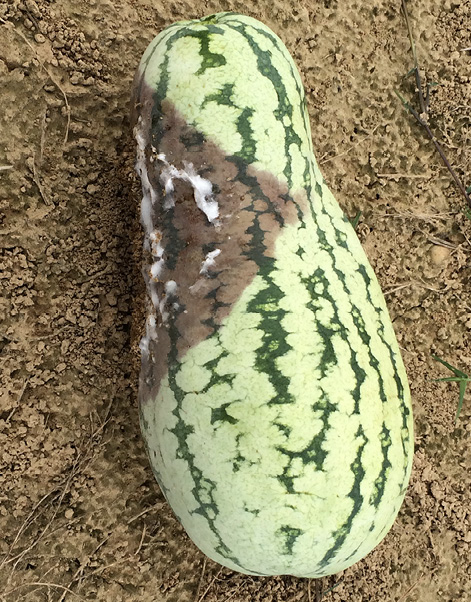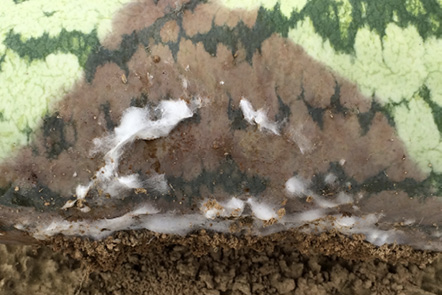Cottony Leak in Cucurbits
Cottony leak, sometimes called Pythium fruit rot or Pythium cottony leak, is a common disease of cucurbits. Cucumber is the most susceptible cucurbit crop, though others may also be affected. The disease is most severe in soil that is wet for part of the growing season.
Signs and Symptoms
In most cucurbits, symptoms begin as brown, water-soaked lesions that quickly develop into soft, rotted areas on the part of the fruit that is in direct contact with the soil (Figure 1). In watermelons, symptoms may begin at the blossom end of the fruit. During humid conditions, white, cottony pathogen growth may be produced and cover the rotted area of the fruit (Figures 1 and 2). The mycelial growth produced by the cottony leak pathogens may be confused with that produced by species of Phytophthora. However, the mycelium produced on rotting fruits infected by Phytophthora spp. is felt-like rather than cottony (Figure 3). In cucumbers, a dark green to brown blister may develop before the previously mentioned symptoms.


Photos: Rebecca A. Melanson, MSU Extension, Bugwood.org.


Pathogen and Disease Spread
Cottony leak is caused by a number of species of Pythium. These pathogens are members of a group of pathogens commonly called water molds. Other species of Pythium are known to cause damping-off and root rots in cucurbit seedlings. The Pythium species that cause cottony leak commonly occur as part of the natural microbial population in the soil. Infection occurs through wounds or where the fruit is in direct contact with wet soil. Pathogen growth is optimal at approximately 82ºF. The pathogen can survive in the soil from season to season in the form of oospores and can be spread in running water and on infested equipment.
Management
Preventing and managing cottony leak in cucurbits is difficult.
Cultural Management
Plant cucurbits in well-drained soils with adequate ditching. Soils should be able to drain rapidly after a heavy rainfall.
Use sufficient plant spacing. Proper plant spacing can help prevent dense vine-matting. Plants should be spaced at the widest recommended in-row interval for each crop. In fields with a previous history of cottony leak, consider increasing the in-row spacing interval beyond the widest recommended interval. See the Southeastern U.S. Vegetable Crop Handbook for spacing recommendations for various cucurbit crops.
Use practices that create a barrier between fruits and soil. This practice may only be practical for small growers. Fruits can be placed on artificial barriers, such as wire or wood, or on top of vines. Plastic mulch can help in dry areas when used with drip irrigation, but it can promote fruit decay in areas with frequent rainfall because depressions in the plastic may hold water.
Choose a site that was planted with a non-host the previous season. Grasses and grains are not hosts for the Pythium species that cause cottony leak. Plantings with a non-host crop help to reduce the amount of inoculum present in soils.
Chemical Management
Apply fungicides that are effective against cottony leak. The fungicides Thrive 4M and Ultra Flourish (active ingredient: mefenoxam) and MetaStar 2E (active ingredient: metalaxyl) are labeled for use against cottony leak on cucurbits and are registered for use in commercial cucurbit production in Mississippi. Both active ingredients are FRAC Group 4 fungicides. These products should be applied before planting (preplant incorporated) or at planting as a soil surface spray; some labels may allow for application by injection into irrigation water. Effectiveness of soil surface applications depends on fungicide movement into the top inch or so of soil by irrigation or rainfall.
Check with your local county Extension office and/or the latest edition of the Southeastern U.S. Vegetable Crop Handbook, as other products labeled for use against cottony leak on cucurbits may become available in the future. Pathogen resistance to products containing menfenoxam has been reported; however, it is not known if resistant pathogen populations are present in Mississippi.
When using fungicides, remember: the label is the law. Read and understand product labels before use, and follow all label instructions.
Reference
Keinath, A., Wintermantel, W. M., and Zitter, T. A. (eds). 2017. Compendium of Cucurbit Diseases and Pests. American Phytopathological Society Press, St. Paul, MN. 220 pages.
Additional Resources
How to Collect and Package Plant Disease Specimens for Diagnosis (M1562)
Pesticide Label Databases (P3155)
Southeastern U.S. Vegetable Crop Handbook, available online or by contacting your local county Extension office.
This work is partially supported by Crop Protection and Pest Management, Extension Implementation Program, award no. 2021-70006-35580 from the USDA National Institute of Food and Agriculture. Any opinions, findings, conclusions, or recommendations expressed in this publication are those of the author(s) and do not necessarily reflect the view of the U.S. Department of Agriculture.
Publication 3210 (POD-06-23)
Prepared by Rebecca A. Melanson, PhD, Assistant Extension Professor, Plant Pathology, Central Mississippi Research and Extension Center. Reviewed by Clarissa Balbalian, Diagnostic Laboratory Manager, MSU Extension; Jeff Wilson, PhD, Assistant Horticulture Professor, North Mississippi Research and Extension Center; Anthony Keinath, PhD, Plant Pathologist, Clemson University; and Angie Rogers, Greene County ANR Extension Agent, MSU Extension.
The Mississippi State University Extension Service is working to ensure all web content is accessible to all users. If you need assistance accessing any of our content, please email the webteam or call 662-325-2262.





